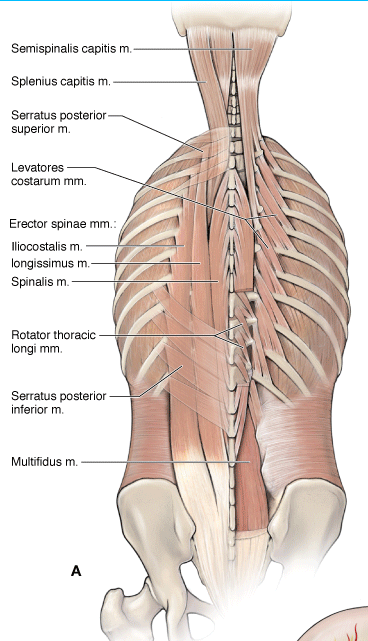Deep Back Muscles
The deep back muscles are segmentally innervated by the dorsal rami of spinal nerves.
The muscles are responsible for maintaining posture and are in constant use during locomotion.
The erector spinae muscles course medially to superolaterally, and they extend the vertebral column and rotate the trunk ipsilaterally.
The transversospinalis group course laterally to superomedially and extend the vertebral column and rotate the trunk contralaterally.


- Splenius Capitis
- Splenius cervicis
- Erector spinae group (a series of muscles that extends from the sacrum to the skull)
- Transversospinalis group
- Study Questions
The splenius capitis lie superficial to the erector spinae and deep to the levator scapulae and rhomboid muscles. The splenius capitis extends and rotates the head, The muscle acts unilaterally (only one side contracts while the other side relaxes), produce lateral flexion of the head and neck.
Muscle
Proximal Attachment
Distal Attachment
Action
Innervation
Spinous processes of T3–T6
Transverse processes of C2–C3
Acting alone, laterally bends and rotates head
Acting together, extend head and neck
Splenius Capitis and Cervicis Muscles
The splenius capitis and splenius cervicis muscles lie superficial to the erector spinae and deep to the levator scapulae and rhomboid muscles. The splenius capitis extends and rotates the head, whereas the splenius cervicis rotates and extends the cervical spine. Both muscles, acting unilaterally (only one side contracts while the other side relaxes), produce lateral flexion of the head and neck.
Muscle
Proximal Attachment
Distal Attachment
Action
Innervation
Erector spinae group (a series of muscles that extends from the sacrum to the skull)
- Iliocostalis
Iliac crest, sacrum, ribs
Thoracolumbar fascia, ribs, cervical vertebrae
Bilaterally, extend vertebral column
Segmentally innervated by dorsal primary rami of spinal nn. at each vertebral level where they attach
- Longissimus
Thoracodorsal fascia, transverse and cervical vertebrae
Vertebrae and mastoid process of temporal bone
Unilaterally, lateral flexion of vertebral column
Muscle
Proximal Attachment
Distal Attachment
Action
Innervation
- Semispinalis
Transverse processes of thoracic vertebrae
Spinous processes of thoracic and cervical vertebrae and occipital bone
Bilaterally, extends vertebral column and unilaterally rotates vertebral column contralaterally
Segmentally innervated by dorsal primary rami of spinal nn. at each vertebral level where they attach
- Multifidus
Sacrum and transverse processes of lumbar, thoracic, and cervical vertebrae
Spinous processes of lumbar, thoracic, and lower cervical vertebrae
Bilaterally, extends vertebral column and unilaterally rotates vertebral column contralaterally
- Rotatores
Transverse processes of C2 vertebra to the sacrum
Lamina immediately above the vertebra of origin
Complete Quiz and View ResultsWhich of the following paired muscles of the back is primarily responsible for extension of the vertebral column?
You will be able to view all answers at the end of your quiz.The correct answer is A. You answered A.
The paired iliocostalis muscles, part of the erector spinae musculature, are postural muscles that help to extend the vertebral column and thus keep the spine erect. The latissimus dorsi, rhomboids, and trapezius muscles act primarily on the upper limb. The levator costarum muscles help to elevate the ribs during inspiration but will not extend the vertebral column.
transversospinalis,
suboccipital muscles.